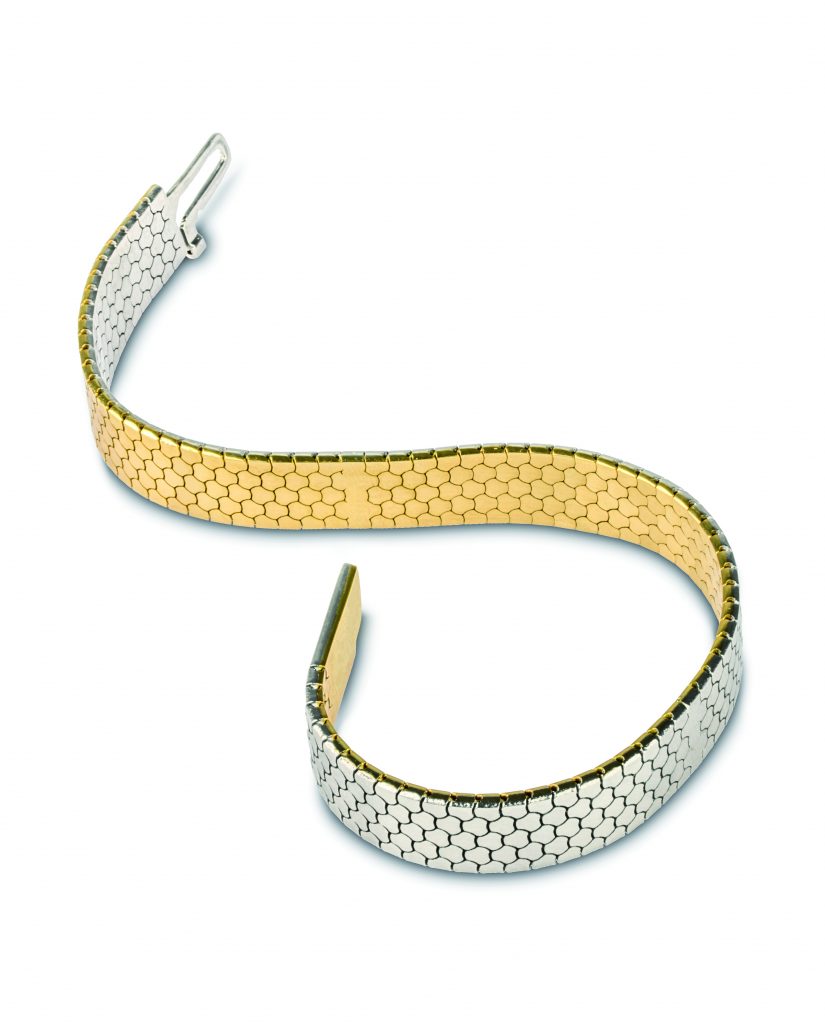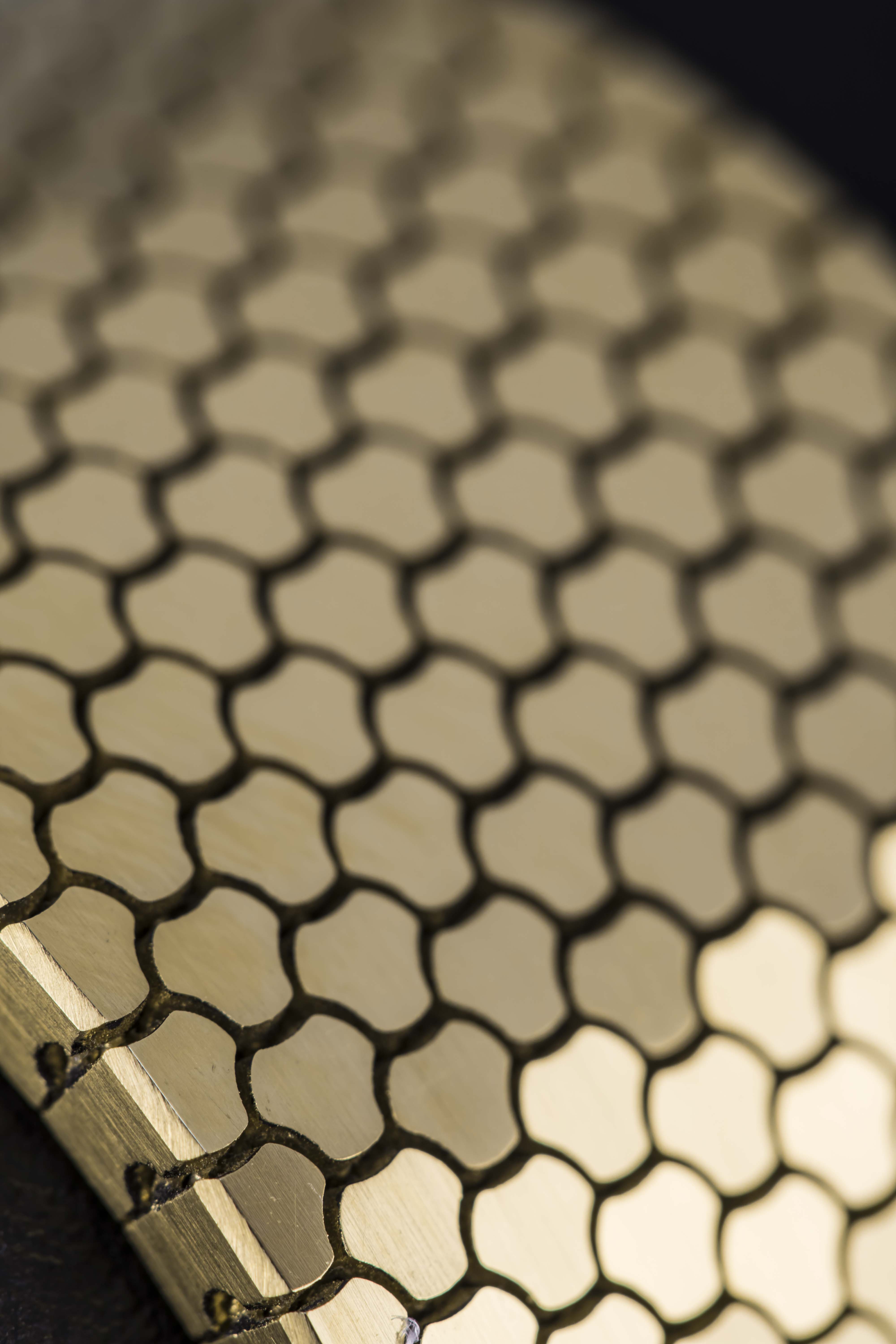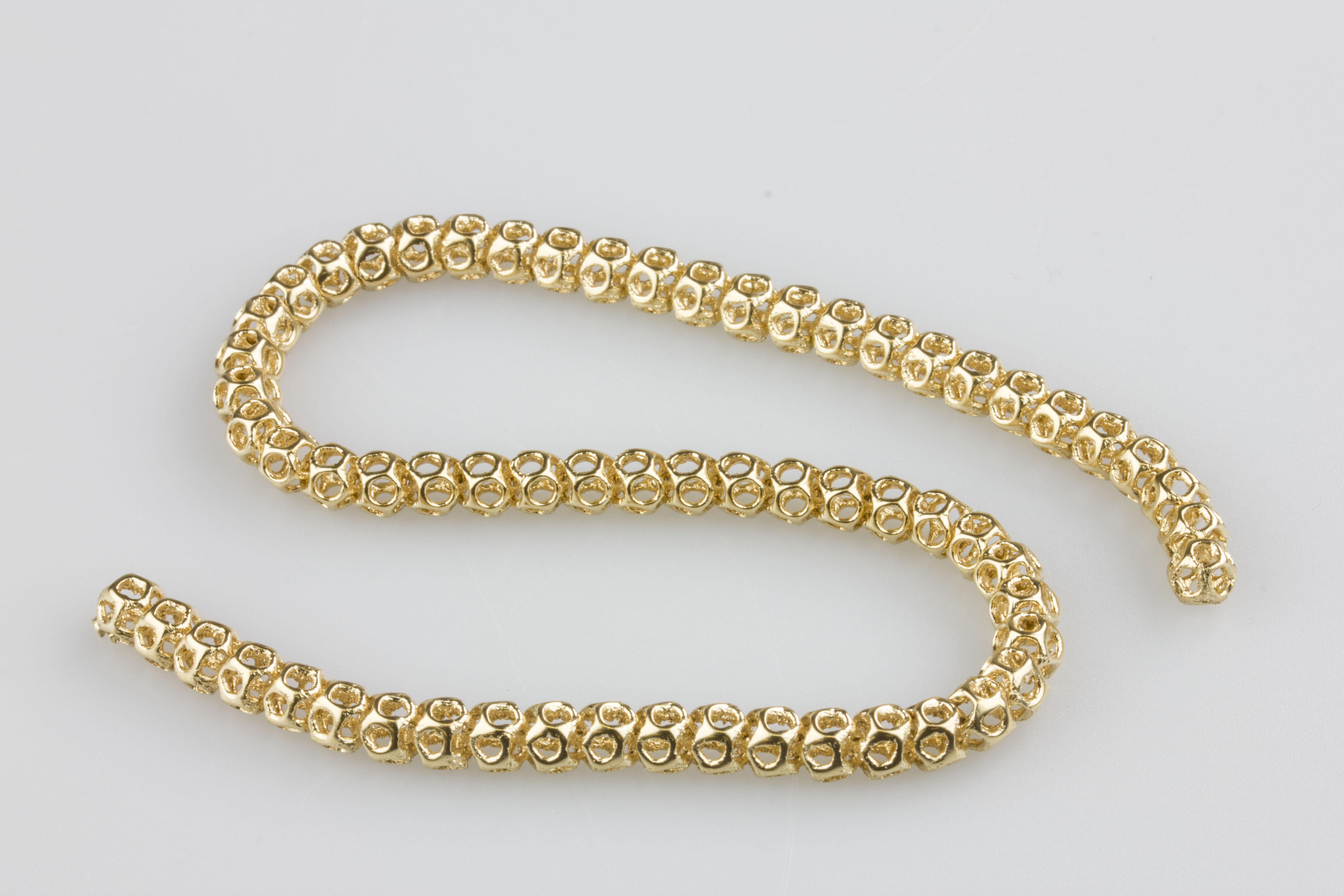
My rather graph and microscope photo filled Linkedin is often enriched by a flash of color. This is either some asinine viral video infecting the formerly useful Linkedin feed or it is, more happily, from an amber fire glow of 3D printed gold jewels. These come courtesy of David Fletcher who kindly peppers my Linkedin feed with lovely 3D printed jewels. David is the Precious Metal 3D Printing Manager at Cookson Gold. David has spent nearly 30 years at Cookson so must have developed quite the layer by layer Midas touch. Cookson is a supplier of all manner of goods to the gold industry from consumables to machines. It itself is a subsidiary of the Heimerle + Meule Group which is a leader in precious metal refining, reclaiming and products for precious metal separation. 3D printing in gold sounded like a panacea when it was first launched. It turns out that it is a bit more complex than initially assumed but by partnering with Powder Bed Fusion leader EOS Cookson has managed to present a gold and precious metal printing online service that has provided jewels for many customers in many different segments. The company also sells and supports EOS M80 and M100 3D printers. I got to know them as the realists in gold printing and found it high time for an interview.
How difficult is it to 3D print gold?
“As with all metal 3D printing the correlation between the system, the powder and the process are key to ensuring good quality parts in your chosen precious metal alloy. Cooksongold part of the Heimerle + Meule Group are able to print in 18k yellow gold, 18k red gold, 18k white gold, 925 silver and 950 platinum and have parameters available for the use on the EOS M080 and M100 systems. These are the only systems developed to handle high value powders to ensure full accountability. Other industrial and jewellery alloy parameters are also in development. We make all our own gas atomised spherical powders internally which are optimised for high “flowability”.”

Why did Cookson Gold move into 3D printing gold?
“As precious metal specialists supplying products and services to jewellery, industrial and dental clients Cooksongold part of the Heimerle + Meule Group were looking for different avenues and areas where we could supply our precious metals. One of the areas that was seeing huge growth was additive manufacturing which was focused on prototyping primarily at that time. Were were keen to push into the technology as we became aware of its advantages over existing production techniques to produce parts that are hollow and lightweight, that articulate cutting down on assembly steps and are highly customisable.”
How much labour is still present in a gold 3D printed part?
“The pre and post processing of precious metal parts is the same as any metal 3D printed part. The major difference is managing every piece of scrap/support/powder to ensure this is recovered and no precious metal is lost. Cooksongold are a major precious metal refiner so we can purchase the scrap alloy and turn this back into fine gold, silver and platinum and then realloy back into useable powder all in house. There are six basic steps to our bureau service – Design: Create the design, optimised and ready for direct precious metal 3D printing. Upload: Send the CAD file in an STL format via our secure portal. Quote: We assess the file and provide a quotation. Print: We build the part layer by layer by melting and solidifying the fine precious metal powder. Post process: We remove the building supports and sand blast ready for shipping. Finish: We deliver the part to our clients your ready-to-finish.”

What kind of customers do you have for it?
“We are dealing with clients from across both industrial and jewellery business channels. Cooksongold have four distinct business channels –
- Cooksongold 3D: Our 3D printing bureau service. These clients range from individuals through to major manufacturers who start with a single product, progressing to a group of products designed for 3D printing with volumes increasing accordingly. In several cases the clients have gone on to purchase the M080 system with support from Cooksongold supplying the parameters and powders.
- Precious Metal Powder Production & Sales: Proving both existing and bespoke alloy powders to the clients requirements. Importantly as a major refiner of precious metals we are able to provide “full chain of custody precious metal alloys” providing a provenance for the precious metals.
- Precious Metal Parameter/Application Development: We provide developed parameters for existing alloys and development of parameters for new alloys to a clients specification. We are also able to carry out development of parameters for a specific application or geometry.
- Precious Metal Recycling & Refining: We carry out scrap precious metal recycling, melt & assay analytical services. We are able to offer gold & silver refining services with our LBMA accreditation. We can also offer our clients metal account trading with precious metal finance option available.
- Finally we work with EOS selling the M080 system and supporting sales of the M100 for precious metal applications.”
What kind of parts are they making?
“The parts we are producing for clients are wide and varied depending on the business channel. The industrial applications we are looking at are incredibly varied using various Platinum alloys and fine silver. In the jewellery world the designs are coming of age with designers now really taking advantage of what is possible from direct precious metal 3D printing. The beautiful pieces from Marie Boltenstern incorporate precious stones and beads into the designs with no evidence of how the stones got there. The watches from Michiel Holthinrichs are amazing timepieces that are completely customisable to the wearer. With the parts we have designed in house such as the 18k bicolour bracelet opening up a whole new world of possibilities for both jewellery and watches.”

Is it primarily one-offs or more series?
“We have clients who are submitting one off parts that are unique and customisable. However we have also seen an increase in series production with repeat orders. many clients start with a single product, progressing to a group of products designed for 3D printing with volumes increasing accordingly.”
So you sell the Eos M-80 machines and are a service?
“This is correct, In addition to offering our own bureau service we sell the M080 systems exclusively on behalf of EOS. As we progress to the M100 system we will focus on our 4 primary business channels supporting clients with their precious metal applications, powders and parameters with EOS handling the system sales and support.”
I know that estimating costs is difficult in metal printing but can you give us an idea of what a standard gold band wedding ring would cost for example?
“As you have indicated costing of all metal 3D printed parts whether non precious metal or precious metal is not simple. The two key factors for precious metal are yield – how much precious metal powder is used to produce supports. And build height – the taller the piece the more 20micron slices required the longer it takes. The approx production cost for a simple 18k yellow D shape or oval wedding ring band would be €60 plus the precious metal content.”

What is the ideal part to print in gold, and a terrible one?
“The ideal part to print is the 18k bicolour mesh bracelet which is a perfect example of design for AM. The part is light weight, articulates and can be customised and importantly it cannot be produced any other way. Parts that can be easily cast are quote often not ideally suited to 3D printing. These parts can be printed but do not take advantage of any of the benefits the technology offers and thus are not cost effective to print.”
Could you walk us through some of the key design rules for gold 3D printing?
“Direct Precious Metal 3D Printing opens up a whole world of possibilities for creating objects which cannot be manufactured using traditional methods such as casting or milling. However, there are certain requirements associated with the process so Cooksongold created the following design guidelines to help our clients achieve the best results possible, in doing so they will be able to create products that were not possible before. Please use the information provided as a guide and as a general rule it is advisable to avoid working to the minimum tolerances in all areas of your design.”
Size
The Precious M080 uses a circular build platform with a diameter of 80mm. Cooksongold therefore specify that all parts should be no bigger than 75mm in diameter and 90mm high.Wall thickness
The minimum wall thickness is 0.3mm however this is dependent on the geometry of the design. We would also recommend increasing this value for larger pieces.Small details and thicknesses.
The general detail resolution of direct precious metal 3D printed parts when processing parts on the Precious M 080 is between 200 µm and 250 µm (these values ensure the production of dense material). The dimensional accuracy of the machine (x,y) is currently in the region of +/- 100µm. An example of dimensional accuracy would be if we built a block 50mm x 50mm x 50mm then the tolerance’s would be 50mm +/- 0.1mm in the x and y direction. The dimensional accuracy in the z direction is controlled by the layer thickness, so the tolerance would be tighter.
Detail resolution refers to the smallest feature size of dense material that can be reproduced on a part. When building extremely small parts any sharp angles or corners may appear slightly rounded.

Supports
Support structures are required on nearly all builds and perform a variety of functions. Their main use is to raise the parts off the build platform so that they can be easily removed once completed. They are also added to pieces which have shallow angles or horizontal sections to prevent deformation. Finally they can also act as a heat sink ensuring the powder melts correctly during the build process.
It is important to consider that supports need to be accessible to be removed so any internal structures need to be self-supporting.
Please be aware that post processing may be required to remove any witness marks left after support removal. We have included some brief examples of supports below to illustrate how small design changes can have a huge impact on the amount of supports required, which in turn will help to optimise the yield of your powder.Angles and overhangs
Horizontal areas and shallow edges angled less than 35 degrees from the platform base will need a support, otherwise the edge of the piece may deform into the loose powder below. This can lead to a rough surface finish in that area or even cause the build to fail. Overhangs or angled walls that do not need supports will achieve a better result than those that do. Adding radii and designing pieces with angles of under 40 degrees from the platform usually eliminates the need for support structures. The more upright the wall, the better the surface finish.

What do you see as the future of 3D printing gold?
“Not limited to gold the future of precious metal 3D printing is very bright. The jewellery industry is now starting to adopt the technology and most importantly designing for the process creating some amazing and unique pieces not thought possible previously. However the biggest area of growth is undoubtedly in industrial applications. The volume of parts and possible applications is staggering with design for AM optimising parts for their function and reducing the high volumes of precious metal required. As the saying goes, The future is very bright.”
Subscribe to Our Email Newsletter
Stay up-to-date on all the latest news from the 3D printing industry and receive information and offers from third party vendors.
You May Also Like
Further Understanding of 3D Printing Design at ADDITIV Design World
ADDITIV is back once again! This time, the virtual platform for additive manufacturing will be holding the first-ever edition of ADDITIV Design World on May 23rd from 9:00 AM –...
3D Printer Maker EVO-tech Reborn as NEVO3D — Once More With Feeling
EVO-tech was a 3D printing service and original equipment manufacturer established in 2013 and based in Schörfling am Attersee, Austria. The company produced high-quality material extrusion systems featuring linear bearings,...
3D Systems Brings 3D Printed PEEK Cranial Implant to the U.S. with FDA Clearance
For more than 10 years, 3D Systems (NYSE:DDD) has worked hand-in-hand with surgeons to plan over 150,000 patient-specific cases, and develop more than two million instruments and implants from its...
CDFAM Returns to Berlin for Second Annual Symposium
The second CDFAM Computational Design Symposium is scheduled for May 7-8, 2024, in Berlin, and will convene leading experts in computational design across all scales. Building upon the first event...































